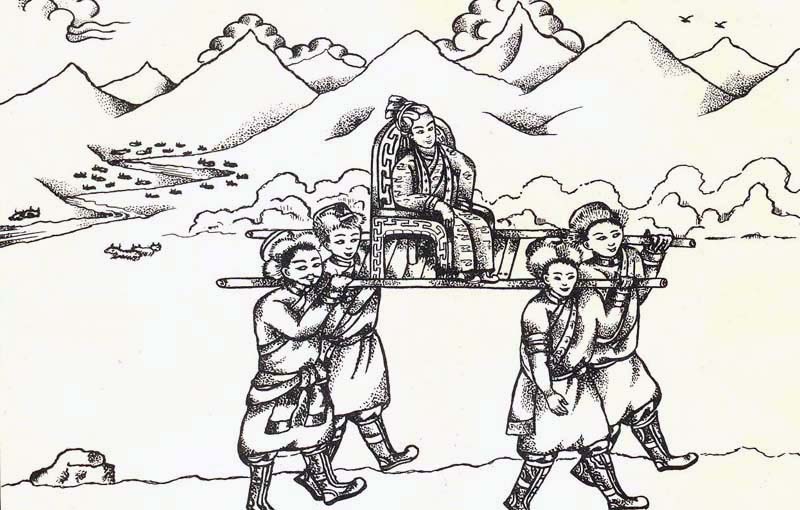The old stories tell us that Nyatri Tsenpo was carried on the Tibetans shoulders to be enthroned as their first king
In the past, traditional accounts of Tibetan history have tended to dismiss the years before King Songtsen Gampo, and the arrival of Buddhism in Tibet, as a time of darkness and barbarity. This is partly because most of the early histories were written by Buddhists, who naturally wished to show that it was Buddhism that brought civilization to the Tibetans. Another reason is that these early writers relied on Chinese information about the Tibetans. The Chinese, at this time, regarded all foreigners as barbaric, and the Tibetans were no exception, so their writings should be treated skeptically. In fact, there is much evidence to suggest that the centuries before the arrival of Buddhism saw a flourishing civilization growing in Tibet. By the time the first known history books were written, Tibet was already a strong and powerful country. Such countries do not grow up overnight.
The first kings of Tibet lived in the southern province of Yarlung, on the border with Bhutan. There are many tales about the origin of the first king. The oldest tales describe him as a god-like being who descended from the sky using a kind of rope ladder. Today, though many historians believe he came from inside Tibet itself. Some Buddhist stories, however, speak of him as the son of a royal Indian family who wandered over the high mountain peaks to Tibet. There he met some herdsmen grazing their yaks. These simple nomads thought that the young man must have come down from the heavens, so they carried him on their shoulders and made him their king. He was named Nyartri Tsenpo, which means ‘neck-enthroned king.’ One reason why Buddhist legend describes the first king of Tibet as coming from India, may be that they wished to suggest that he was a relative of the Buddha.
The old tales say that Nyatri Tsenpo, and the six kings who followed him, did not die. No tombs for them have been found anywhere in Tibet. The story goes that they climbed back into the sky using the same rope-ladder with which Nyatri Tsenpo first descended. (This story was probably a simple way of explaining how the spirits of the kings went to heaven.) The eighth king, Drigum, carried a different fate. He quarreled with one of his ministers. The ministers conjured up some terrible magic against him and cut the ladder between heaven and earth. After this, the kings were buried in tombs near the capital of Yarlung.
It is possible that the story of the cutting of the heavenly ladder refers to the defeat and death of Drigum by a group of disloyal nobles. Drigum’s son, Podegunngyal, eventually became the ninth king after a period of exile. It was at about this time that certain changes took place in the Yarlung kingdom. Podegungyal introduced a religion called Bon, which became very closely linked with the royal family. The kings themselves were believed to be gods, but the greater power lay with the Bon priests who conducted the all-important royal ceremonies. The most important of these took place when a king died. The Bon priests received powerful support from many of the Yarlung nobles, and increasingly from the ordinary people as well. Their influence began to spread over more and more of Tibet. In this way, and doubtless through a good many hard-fought battles as well, the different tribes of Tibet came under the rule of the kings of Yarlung and their Bon ministers. And, as more tribes were conquered, or won over, so the king’s government grew more and more efficient and well-organized.
At the beginning of the seventh century AD, all of Tibet was united under the rule of Namri Srongtsen, the thirty-second king. He had a fearsome reputation. Even the Chinese feared his ferocity in battle and the strength of his armies. His son, Songtsen Gampo, was to become the most famous king ever to rule Tibet.

